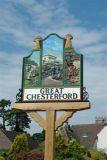
GREAT
CHESTERFORD

 |
The
History Of Great Chesterford
|
 |
| Homepage | Great Chesterford Index Page |
The
land
around Great Chesterford has been inhabited for centuries, and there
have been many archaeological finds e.g. Bronze Age beakers, Belgic
pottery and
jewellery, and many Roman artefacts which can be found in both Saffron
Walden and
Cambridge museums. In the 1st century AD, a
Romano-British civil
settlement was established near the river, occupying an important site
en route between
London, Cambridge and Newmarket. They erected many buildings,including
a tax office, and a temple which was excavated to the east of
the town near the Belgic cemetery.
In the 4th century the Romans built a
wall
around the town – remains
have been found and its exact location is known. In fact it
passed underneath what is now the Crown House Hotel.
After
the
Romans left, it was presumed that there was continuity of occupation
through the Saxon period, probably outside the Roman town. The only
actual
evidence of Saxon occupation is found in the burial sites. Medieval
development was
in the centre of the village. The name Chesterford is first mentioned
in a
document in 1004, and again in 1086 in the Domesday Book. In 1459 the
Rector Thomas
Hyll endowed a charity for the benefit of needy parishioners. This
still
exists today.
In 1514 a school was licensed, and in 1540
Gt. Chesterford was described as being a purely agricultural community.
By medieval times Great Chesterford was
a town of some importance with a weekly market (confirmed later by a
charter from Charles I in 1634), and a Fair held on St John the Baptist
Day.
By 1635 it grew in importance as a staging
post for the Newmarket Races, often used by Charles I, who drew quite a
crowd of onlookers. Complaints about
gambling and noisy revelry at the Crown House (then a coaching inn) and
its environs
on Easter Sunday by travellers to the races eventually led to a ban on
Sunday racing. Newmarket Races adhere to the ban to this day.